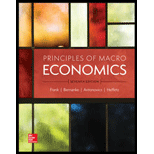
PRINCIPLES OF MACROECONOMICS(LOOSELEAF)
7th Edition
ISBN: 9781260110920
Author: Frank
Publisher: MCG
expand_more
expand_more
format_list_bulleted
Question
Chapter 10, Problem 3P
(a)
To determine
Determine the deposits and money supply in the economy.
(b)
To determine
Determine the currency held by the public and bank reserves.
(c)
To determine
Determine the desired reserve deposit ratio.
Expert Solution & Answer
Want to see the full answer?
Check out a sample textbook solution
Students have asked these similar questions
In announcing tariffs on imported steel and aluminum last week, the President said he was imposing a tax on foreign manufacturers who seek to export to the U.S. Is that a fair description of what he did and who will pay? Explain your answer.
Anticipating a severe winter storm, stores stock up on snow shovels and consumers buy snow shovels to be able to clear access to their property. What happens to the price and quantity of snow shovels in the days leading up to the storm
In the context of supply and demand, describe what equilibrium means? Can a shortage or surplus exist in a market that is left to its own devices? Explain.
Chapter 10 Solutions
PRINCIPLES OF MACROECONOMICS(LOOSELEAF)
Knowledge Booster
Similar questions
- Typically, spending in an economy is divided into four components. What are they? Which is the largest component? Which is the most steady from one period to another? Which is most volatile from one period to another? Explain why for your two previous answers.arrow_forwardMichelle Wie, a teenage golf prodigy, earned $16 million from endorsements and $4 million in prize money in 2006. In 2007, she announced that she would enroll in Stanford University for the Fall term. What was her opportunity cost for the 2007-2008 academic year? How does it compare to your opportunity cost of a year at University?arrow_forwardWhy do we add up total spending to compute GDP when GDP is supposed to be measuring production?arrow_forward
- not use ai pleasearrow_forwardGDP 2017 Q3 2.8% Equipment 9.8% Nonresidential Structures 5.7% 2017 Q4 2.3 9.9 1.3% 2018 Q1 2.2 8.5 13.9 2018 Q2 4.2 4.6 14.5 2018 Q3 3.4 3.4 -3.4 2018 Q4 2.2 6.6 -3.9 (Note: all figures on an annual rate basis) The quarterly growth rates of real GDP and investment spending on equipment and structures for the six quarters prior to the pandemic are described above. In his first term in office, Trump lowered both personal and corporate income tax rates, expecting these moves to generate stronger growth. These took effect in January 2018 although the taxes withheld from paychecks did not drop immediately. Based on the data above, did the tax cuts do what they were expected to do? Be specific.arrow_forwardEconomists prefer to analyze the performance of the economy using “real” rather than nominal measures of economic activity. First, what does it mean to use real variables using consumption and wages as cases in point? Warning: before you throw at me the catch-all “adjusted for inflation” answer, know that I am looking for a thoughtful answer that explains in everyday English the difference between real and nominal and why it matters in the context of wages and interest rates.arrow_forward
- not use ai pleseaarrow_forward3 Producer Surplus, PS $12 $11 S Book Print rences Legend ●Demand ● Supply Price $10 $9 $8 $7 $6 D $5 0 1 2 3 4 5 6 7 8 00 Tons of Wheat (in thousands) 9 10 a. Indicate the consumer surplus if the market is in equilibrium. Instructions: Use the tool provided "Consumer Surplus, CS" to shade in the consumer surplus area on the graph. b. Indicate the producer surplus if the market is in equilibrium. Instructions: Use the tool provided "Producer Surplus, PS" to shade in the producer surplus area on the graph.arrow_forwardFigure 4-4 PRICE a P B Q a QUANTITY Supply Refer to Figure 4-4. The movement from point A to point B on the graph is called a decrease in supply. an increase in supply. an increase in the quantity supplied. a decrease in the quantity supplied. tv all A 18arrow_forward
arrow_back_ios
SEE MORE QUESTIONS
arrow_forward_ios
Recommended textbooks for you



 Macroeconomics: Private and Public Choice (MindTa...EconomicsISBN:9781305506756Author:James D. Gwartney, Richard L. Stroup, Russell S. Sobel, David A. MacphersonPublisher:Cengage Learning
Macroeconomics: Private and Public Choice (MindTa...EconomicsISBN:9781305506756Author:James D. Gwartney, Richard L. Stroup, Russell S. Sobel, David A. MacphersonPublisher:Cengage Learning Economics: Private and Public Choice (MindTap Cou...EconomicsISBN:9781305506725Author:James D. Gwartney, Richard L. Stroup, Russell S. Sobel, David A. MacphersonPublisher:Cengage Learning
Economics: Private and Public Choice (MindTap Cou...EconomicsISBN:9781305506725Author:James D. Gwartney, Richard L. Stroup, Russell S. Sobel, David A. MacphersonPublisher:Cengage Learning Economics (MindTap Course List)EconomicsISBN:9781337617383Author:Roger A. ArnoldPublisher:Cengage Learning
Economics (MindTap Course List)EconomicsISBN:9781337617383Author:Roger A. ArnoldPublisher:Cengage Learning




Macroeconomics: Private and Public Choice (MindTa...
Economics
ISBN:9781305506756
Author:James D. Gwartney, Richard L. Stroup, Russell S. Sobel, David A. Macpherson
Publisher:Cengage Learning

Economics: Private and Public Choice (MindTap Cou...
Economics
ISBN:9781305506725
Author:James D. Gwartney, Richard L. Stroup, Russell S. Sobel, David A. Macpherson
Publisher:Cengage Learning

Economics (MindTap Course List)
Economics
ISBN:9781337617383
Author:Roger A. Arnold
Publisher:Cengage Learning